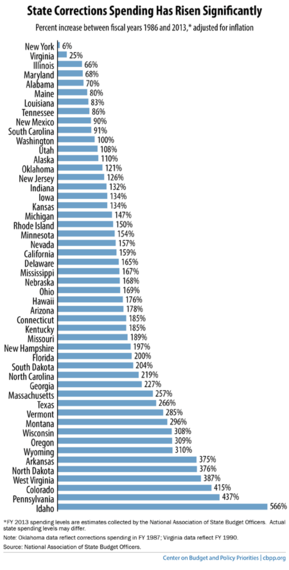The huge growth in state prison populations in recent decades has created mounting budget challenges for states, our new report explains. State economies would be much stronger over time if states invested more in education and other areas that can boost long-term economic growth and less in maintaining extremely high prison populations.
If states were still spending on corrections what they spent in the mid-1980s, adjusted for inflation, they would have about $28 billion more each year that they could spend on more productive investments or a mix of investments and tax reductions.
Most states' prison populations are at historic highs; in 36 states, the prison population has more than tripled as a share of state population since 1978. This growth, which continued even after crime rates fell substantially in the 1990s, has been costly. Corrections spending rose in every state between 1986 and 2013, after adjusting for inflation (see graph below), climbing from $20 billion nationally to over $47 billion. Corrections spending is now the third-largest category of spending in most states, behind education and health care.
At the same time, states are under-investing in educating children and young adults, especially those in high-poverty neighborhoods. At least 30 states are providing less general funding per student this year for K-12 schools than before the recession, after adjusting for inflation; in 14 states, the reduction exceeds 10 percent.
Higher education cuts have been even deeper: the average state has cut higher education funding per student by 23 percent since the recession hit, after adjusting for inflation. Eleven states spent more of their general funds on corrections than on higher education in 2013.
Moreover, some states with the biggest education cuts in recent years are among those with the nation's highest incarceration rates.
States can reduce their incarceration rates -- without harming public safety -- through such reforms as reclassifying low-level felonies to misdemeanors where appropriate, expanding the use of alternatives to prison (such as fines and victim restitution), and eliminating prison sentences for technical violations of parole/probation where no new crime was committed. And they could use the freed-up funds in a number of ways, such as expanding access to high-quality preschool, reducing class sizes in high-poverty schools, and revising state funding formulas to invest more in high-poverty neighborhoods. (We'll discuss these criminal justice and education reforms in more detail in future posts.)
The savings from criminal justice reforms wouldn't fully finance the increased education investments needed, partly because states will likely spend much of the savings elsewhere. But reordering state priorities away from maintaining large prison populations and toward investing in human capital will pay off over the long term.
